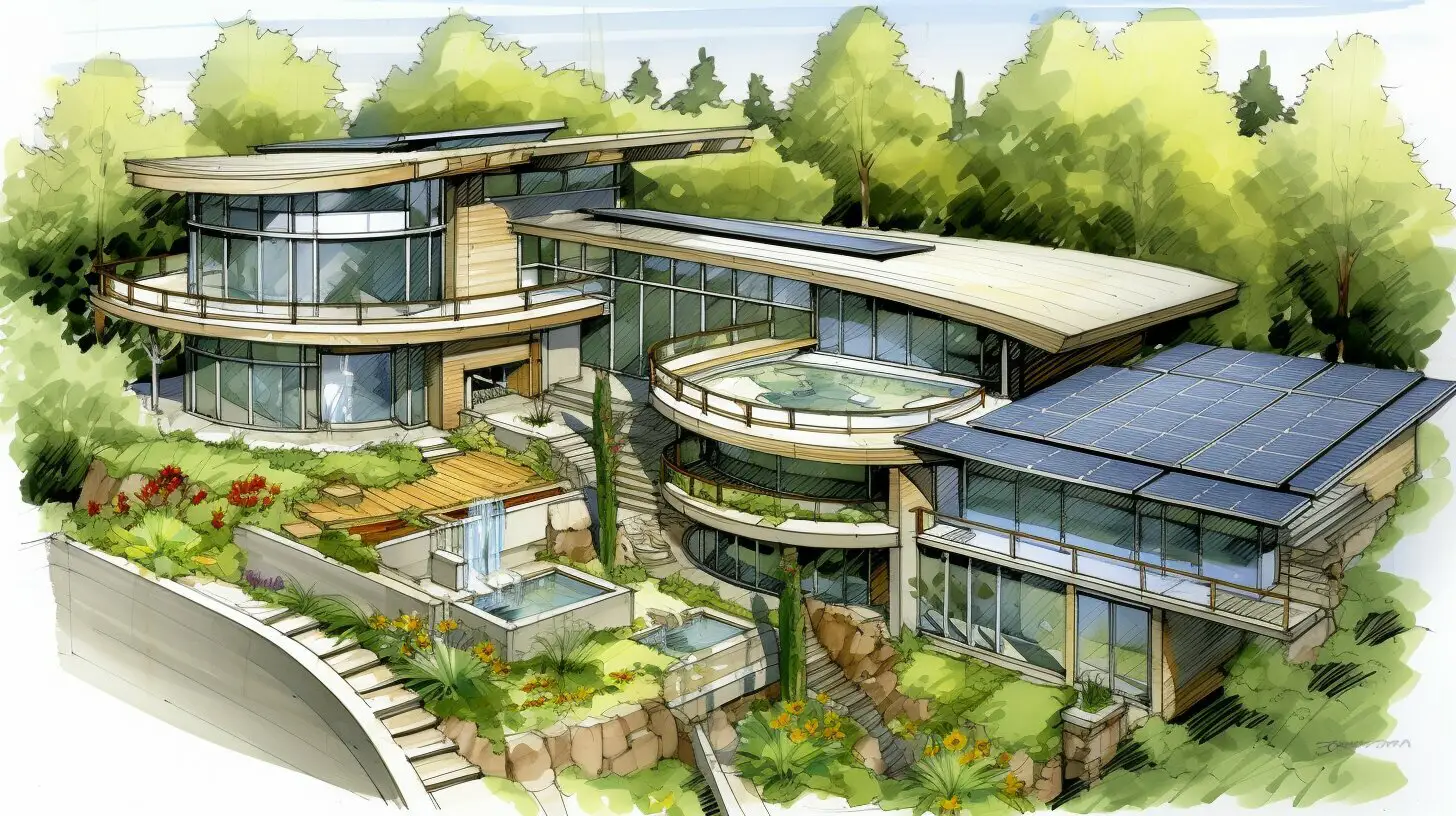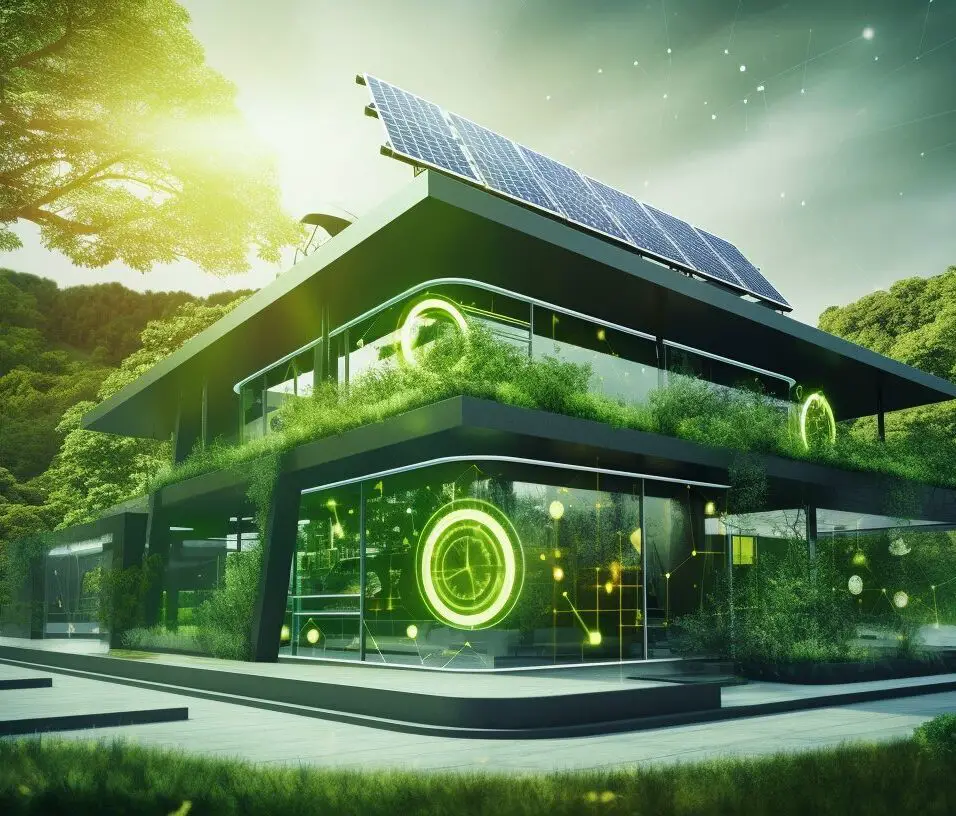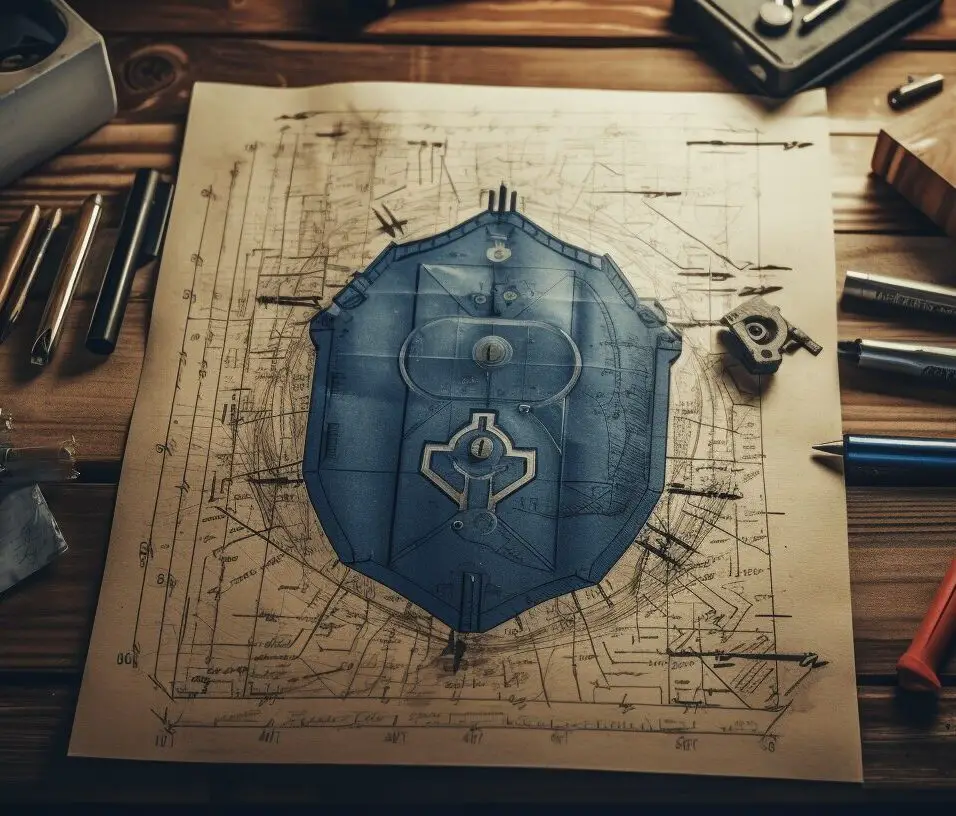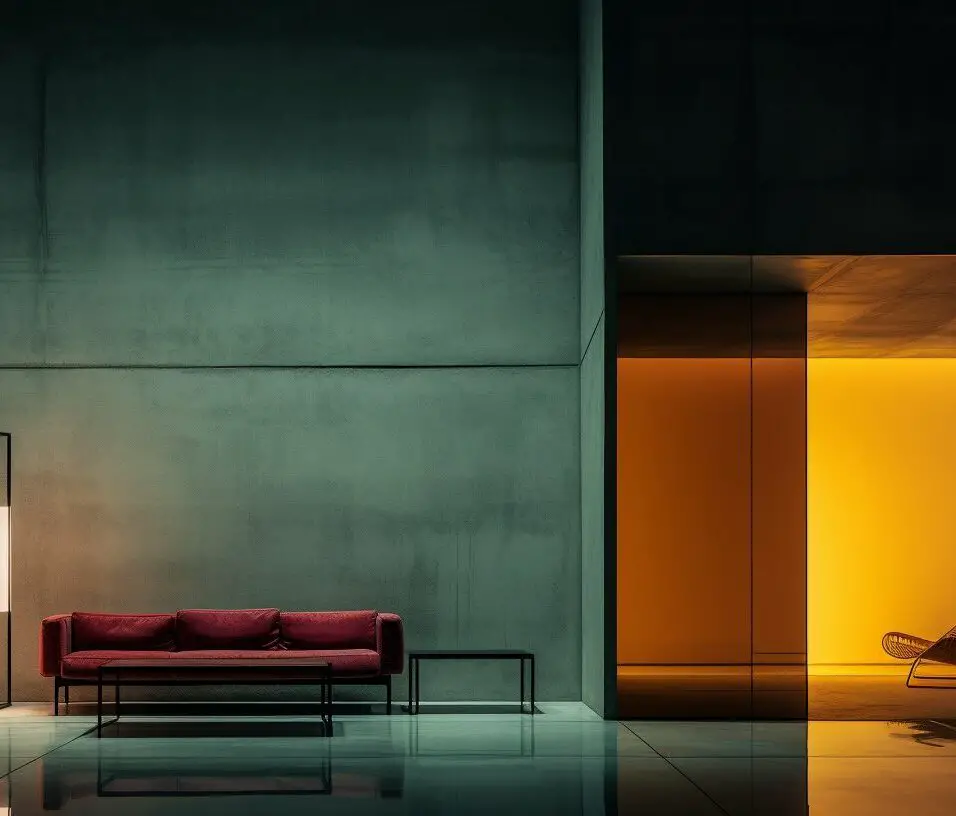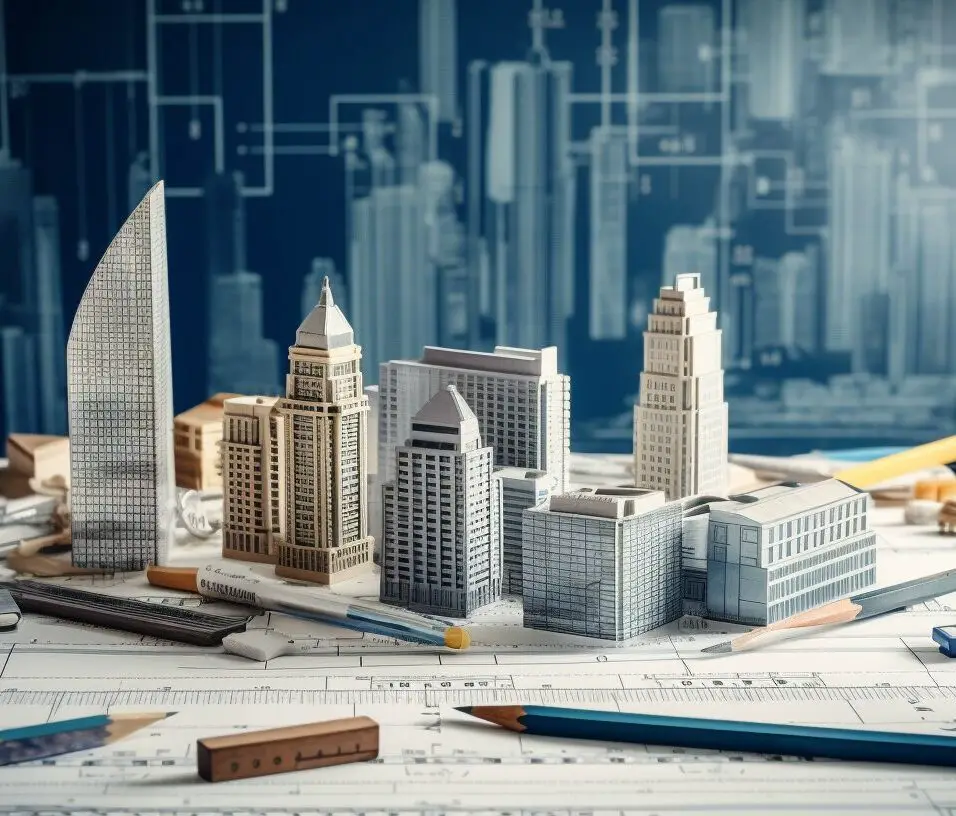How to design a sustainable building?
Sustainable building design is an art that combines sustainable architecture, construction, planning, interior design, and landscaping techniques to minimize negative impacts on the environment. It involves creating eco-friendly structures that prioritize efficiency and contribute to a greener future.
Key Takeaways:
- Sustainable building design encompasses various disciplines to minimize environmental impact.
- Strategies like passive and active sustainable design, renewable energy systems, and sustainable materials are crucial in sustainable building design.
- Optimizing site potential, energy use, water protection and conservation, indoor environmental quality, and operational and maintenance practices are key considerations.
- Sustainable building design offers not only environmental benefits but also cost savings and improved occupant well-being.
Incorporating Sustainable Architecture
Sustainable architecture forms the foundation of sustainable building design, focusing on integrating environmentally conscious practices into the overall design process. It involves a holistic approach that takes into account the environmental impact of every aspect of the building, from its construction to its day-to-day operations. By incorporating sustainable architecture principles, designers can create buildings that minimize negative environmental effects and promote a more sustainable future.
One important aspect of sustainable architecture is the use of energy-efficient materials and construction techniques. By selecting materials with low embodied energy, such as recycled or locally sourced materials, architects can reduce the carbon footprint of a building. Additionally, sustainable architecture emphasizes the importance of passive design strategies, such as proper insulation, natural ventilation, and shading, to minimize the need for artificial heating and cooling.
Another key consideration in sustainable building design is the integration of renewable energy systems. This can include the use of solar panels, wind turbines, or geothermal energy to generate electricity or heat for the building. By harnessing renewable energy sources, buildings can significantly reduce their reliance on fossil fuels and decrease their environmental impact.
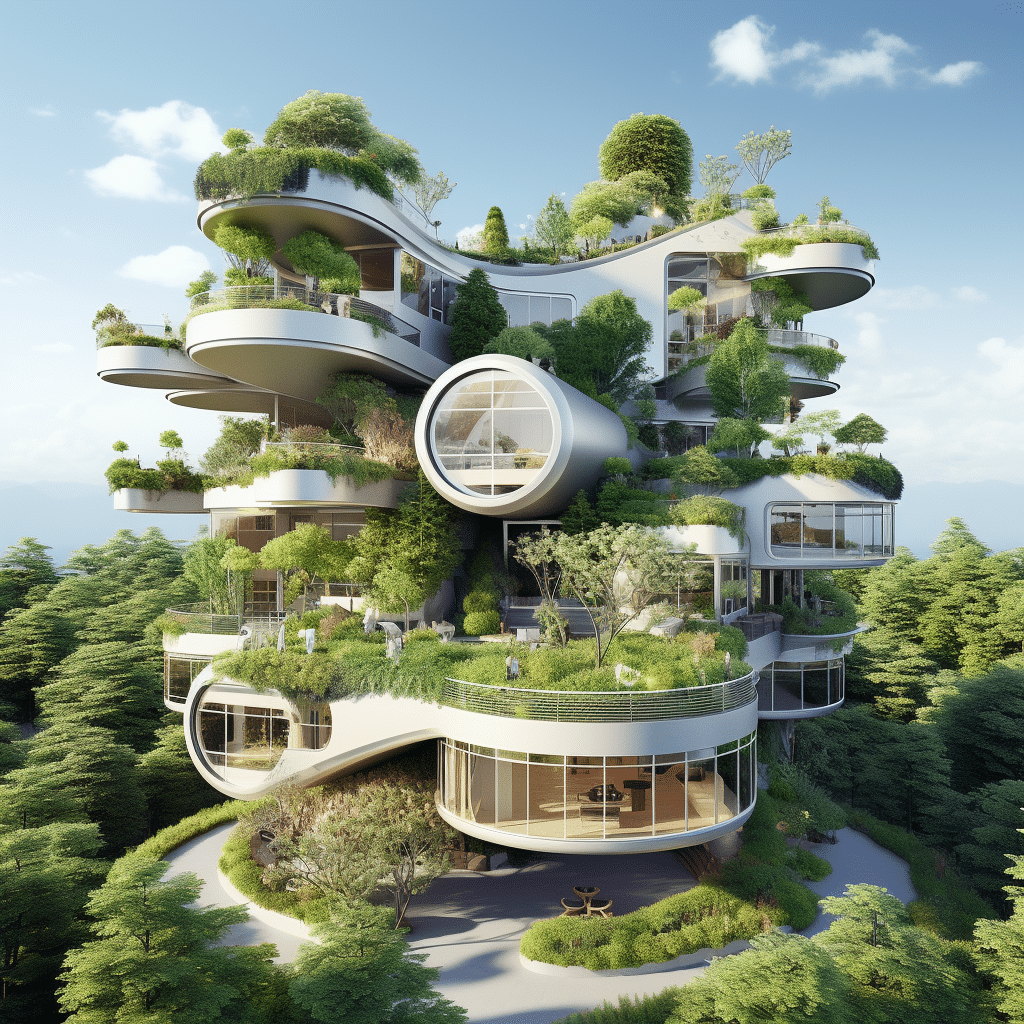
The Benefits of Sustainable Architecture
| Benefits of Sustainable Architecture |
|---|
| Reduces environmental impact |
| Improves energy efficiency |
| Enhances occupant well-being |
| Reduces operating costs |
Sustainable architecture also considers the well-being of occupants by creating healthy and comfortable indoor environments. This can be achieved through the use of natural lighting, proper ventilation systems, and the avoidance of toxic materials. By prioritizing indoor environmental quality, sustainable buildings promote the health and well-being of their occupants.
Incorporating sustainable architecture practices into building design is not only beneficial for the environment but also offers long-term cost savings and enhances the overall quality of the built environment. By embracing sustainable design principles, architects and designers have the power to shape a greener future while creating buildings that are both functional and aesthetically pleasing.
Incorporating Sustainable Architecture
Key Points
- Sustainable architecture focuses on integrating environmentally conscious practices into building design
- Energy-efficient materials and construction techniques are essential in sustainable building design
- Renewable energy systems play a crucial role in reducing environmental impact
- Sustainable architecture prioritizes the well-being of occupants through indoor environmental quality
Passive and Active Sustainable Design
Passive and active sustainable design are two approaches that aim to maximize energy efficiency in buildings, optimizing their performance while reducing reliance on non-renewable energy sources. These design strategies play a crucial role in creating sustainable buildings that are not only environmentally friendly but also cost-effective in the long run.
Passive Sustainable Design
Passive sustainable design focuses on utilizing natural resources and the building’s surroundings to minimize energy consumption. It involves careful consideration of factors such as orientation, insulation, and shading to regulate temperature and maximize natural light. By harnessing the power of sunlight, air ventilation, and thermal mass, passive design strategies can significantly reduce the need for mechanical heating, cooling, and lighting systems. This leads to lower energy demand, decreased greenhouse gas emissions, and improved indoor comfort.
Active Sustainable Design
Active sustainable design, on the other hand, involves the use of technology and renewable energy systems to enhance energy efficiency. This includes the integration of solar panels, wind turbines, geothermal heating and cooling systems, and energy-efficient appliances. Active design strategies enable the building to generate and utilize clean, renewable energy, reducing reliance on fossil fuels and minimizing the carbon footprint. Additionally, advanced control systems and smart technologies can optimize energy use by monitoring and adjusting consumption based on occupancy and conditions.
By combining passive and active sustainable design principles, buildings can achieve optimal energy efficiency and sustainability. The integration of these strategies not only reduces environmental impact but also offers financial benefits, such as lower energy bills and increased property value. Moreover, sustainable buildings provide healthier and more comfortable living and working environments, promoting the well-being and productivity of occupants. As we strive for a greener future, incorporating passive and active sustainable design is crucial in creating buildings that harmonize with the environment and contribute to a more sustainable world.
Renewable Energy Systems
Incorporating renewable energy systems into sustainable building design offers an impactful way to reduce reliance on fossil fuels and promote the use of cleaner and more sustainable energy sources. By harnessing the power of renewable energy, buildings can significantly decrease their carbon footprint and contribute to a greener future.
There are various types of renewable energy systems that can be integrated into sustainable building design. These include solar power, wind turbines, geothermal energy, and hydroelectric power. Each system has its own unique advantages and considerations, allowing builders to choose the most appropriate option based on the location and specific requirements of the building.
One of the key benefits of renewable energy systems is their ability to generate electricity without depleting finite resources or releasing harmful emissions. Solar panels, for example, convert sunlight into electricity, while wind turbines harness the power of wind energy. These systems provide a sustainable and reliable source of energy, reducing the reliance on fossil fuels and helping to combat climate change.
Table: Types of Renewable Energy Systems
| Type | Advantages | Considerations |
|---|---|---|
| Solar Power | – Clean and abundant source of energy – Reduces electricity bills – Minimal maintenance required | – Initial installation cost – Variability in energy output |
| Wind Turbines | – Harnesses renewable wind energy – Reliable power source – Can be installed in various locations | – Space requirement – Noise concerns – Potential impact on wildlife |
| Geothermal Energy | – Utilizes heat from the Earth’s core – Renewable and reliable – Increases energy independence | – Limited availability in certain areas – High upfront costs – Potential for ground disturbance |
| Hydroelectric Power | – Generates clean electricity – Utilizes the power of flowing water – Long lifespan and low operating costs | – Limited availability of suitable sites – Potential environmental impact – Disruption to aquatic ecosystems |
By incorporating renewable energy systems into sustainable building design, we can create structures that not only benefit the environment but also offer long-term cost savings and improved occupant well-being. Investing in sustainable design practices and embracing clean energy sources is crucial for a sustainable and prosperous future.
Sustainable Materials
Selecting and utilizing sustainable materials is crucial for creating buildings that minimize their environmental footprint and contribute to a more sustainable future. By incorporating eco-friendly construction practices, architects and designers can significantly reduce the negative impact of buildings on the planet and create environmentally responsible structures.
One important aspect of sustainable building design is the use of renewable materials. These materials are sourced from rapidly renewable resources, such as bamboo, cork, and straw, which replenish quickly and have a lower carbon footprint compared to traditional materials. Additionally, recycled materials, such as reclaimed wood or recycled steel, can be used to minimize waste and reduce the demand for new raw materials.
Another key consideration is the manufacturing process of materials. Opting for materials with a low carbon footprint, such as those produced using energy-efficient or low-impact manufacturing processes, can further reduce environmental impact. For example, selecting concrete that utilizes alternative cementitious materials like fly ash or slag can significantly reduce CO2 emissions compared to traditional concrete production.
Incorporating Sustainable Materials
When incorporating sustainable materials in building design, it is important to consider their durability and life cycle. Choosing materials that are long-lasting and require minimal maintenance can reduce the need for replacements and repairs, ultimately reducing waste and conserving resources. Additionally, selecting materials that are non-toxic and low in volatile organic compounds (VOCs) ensures a healthier indoor environment for building occupants.
Table 1 provides an overview of commonly used sustainable materials, their benefits, and considerations for their use in building design:
| Material | Benefits | Considerations |
|---|---|---|
| Bamboo | – Rapidly renewable resource – High tensile strength – Low embodied energy | – Sourcing from well-managed forests – Treating for durability |
| Recycled Steel | – Reduces demand for new steel production – High strength-to-weight ratio | – Requires energy-intensive manufacturing – Recycling process considerations |
| Low-Emissive Glass | – Improves energy efficiency – Reduces heat transfer – Allows natural light | – Higher initial cost – Specific glazing requirements |
By consciously selecting and incorporating sustainable materials, architects and designers can play a vital role in creating environmentally responsible buildings that contribute to a greener future. In addition to minimizing the environmental impact, using sustainable materials offers benefits such as improved energy efficiency, reduced carbon emissions, and improved occupant health and well-being.
Optimizing Site Potential
Optimizing site potential is a key aspect of sustainable building design, as it involves careful consideration of the location, orientation, and surrounding environment to maximize energy efficiency and minimize disturbance to ecosystems. By strategically analyzing the site, architects and designers can harness natural resources and minimize the negative impacts of construction on the environment.
One important consideration when optimizing site potential is site selection. Choosing a location that takes advantage of existing infrastructure and minimizes the need for new construction can significantly reduce environmental impact. Additionally, selecting a site with access to public transportation and amenities promotes sustainable living patterns and reduces reliance on private vehicles.
The orientation of a building is another critical factor in sustainable design. By aligning the building with the path of the sun, designers can optimize natural lighting and reduce the need for artificial lighting during the day. Proper orientation also allows for passive solar heating in colder climates, further reducing energy consumption.
Landscaping techniques also play a role in optimizing site potential. By carefully selecting and arranging vegetation, including native plants, designers can create green spaces that enhance biodiversity and provide natural cooling and shading. These features not only contribute to the overall aesthetics of the building but also improve air quality, reduce stormwater runoff, and create a healthier environment for occupants.
| Site Potential Strategies | Benefits |
|---|---|
| Site selection and proximity to amenities | Reduces reliance on private vehicles and minimizes environmental impact |
| Building orientation for optimal natural lighting | Reduces energy consumption and improves occupant well-being |
| Landscaping with native plants | Enhances biodiversity, improves air quality, and reduces stormwater runoff |
Optimizing Energy Use
Optimizing energy use is a fundamental element of sustainable building design, promoting energy efficiency and reducing the environmental impact associated with excessive energy consumption. By incorporating innovative strategies and technologies, architects and designers can create buildings that not only minimize energy waste but also harness renewable energy sources to meet their operational needs.
One of the key approaches to optimizing energy use is through efficient insulation. By using high-quality insulation materials and ensuring proper installation, buildings can retain heat in colder climates and remain cool in warmer climates, reducing the need for excessive heating and cooling systems.
Another strategy is the implementation of smart lighting systems. These systems utilize sensors and controls to adjust lighting levels based on occupancy and natural light availability. By intelligently managing lighting usage, buildings can significantly reduce energy consumption and enhance occupant comfort.
Furthermore, energy management strategies play a vital role in minimizing energy waste. Building automation systems can monitor and control various energy-consuming systems, such as heating, ventilation, and air conditioning (HVAC) systems, to optimize their performance and reduce energy usage. This includes setting temperature schedules, adjusting airflow rates, and utilizing energy-efficient equipment.
| Benefits of Optimizing Energy Use in Sustainable Building Design |
|---|
| 1. Reduced energy costs. |
| 2. Lower environmental impact through reduced greenhouse gas emissions. |
| 3. Improved occupant comfort and well-being. |
| 4. Enhanced building performance and longevity. |
Optimizing energy use in sustainable building design not only benefits the environment but also offers significant cost savings and improves the overall experience for building occupants. By prioritizing energy efficiency and embracing innovative technologies, we can pave the way for a greener and more sustainable future.
Protecting and Conserving Water
Water conservation is crucial to sustainable building design, reducing water waste and improving water management. Designers and builders may save money, promote responsible water use, and contribute to a sustainable future by conserving water.
Water conservation can be achieved with efficient systems. These systems use low-flow faucets, showers, and toilets to save water without sacrificing performance. Rainwater collecting systems can also be used for irrigation and toilet flushing, reducing freshwater use.
“Water is a precious resource, and as sustainable building designers, we have a responsibility to use it wisely. By incorporating efficient water systems and conservation practices, we can make a significant impact on reducing water waste and ensuring the long-term availability of this vital resource.” – John Smith, Sustainable Architect
Another essential consideration in sustainable building design is the use of landscaping techniques that promote water efficiency. This can include the selection of native plants that are well-adapted to the climate and require minimal irrigation. Additionally, utilizing permeable surfaces and incorporating rain gardens can help to manage stormwater runoff and promote groundwater recharge, further contributing to water conservation efforts.
| Benefits of Water Conservation in Sustainable Building Design |
|---|
| 1. Reduced water consumption and cost savings |
| 2. Preservation of freshwater resources |
| 3. Minimized strain on wastewater treatment systems |
| 4. Enhanced resilience to water scarcity and drought conditions |
In conclusion, protecting and conserving water in sustainable building design is not only crucial for environmental preservation but also offers numerous benefits, both economically and socially. By incorporating efficient water systems, implementing conservation practices, and designing water-efficient landscapes, we can create buildings that support responsible water management and contribute to a more sustainable future.
Enhancing Indoor Environmental Quality
Enhancing indoor environmental quality is a key objective in sustainable building design, prioritizing the well-being and health of occupants by ensuring optimal indoor air quality, lighting, and thermal comfort. When designing a sustainable building, it is crucial to create a healthy indoor environment that promotes productivity, reduces health issues, and improves overall occupant satisfaction. Several strategies can be implemented to achieve this goal.
One of the main factors to consider is indoor air quality (IAQ). Poor IAQ can lead to various health problems, including respiratory issues and allergies. To ensure good air quality, sustainable buildings incorporate effective ventilation systems that provide a constant supply of fresh air and remove pollutants. The use of low-emission materials in construction and interior finishes also contributes to maintaining a healthy indoor environment.
Proper lighting is another essential aspect of indoor environmental quality. Sustainable buildings prioritize natural lighting whenever possible, as it not only reduces energy consumption but also enhances occupant well-being. Incorporating large windows, skylights, and light shelves can maximize daylight while minimizing the need for artificial lighting. Additionally, the use of energy-efficient lighting fixtures and controls further enhances indoor lighting quality.
Indoor Environmental Quality
Thermal comfort is also of utmost importance in sustainable building design. Ensuring that occupants feel comfortable in terms of temperature and humidity levels contributes to their well-being and productivity. Sustainable buildings incorporate energy-efficient heating, ventilation, and air conditioning (HVAC) systems that maintain optimal thermal conditions while minimizing energy consumption. Additionally, the use of insulation, shading devices, and natural ventilation techniques helps regulate indoor temperature and reduce reliance on mechanical cooling and heating.
| Strategies for Enhancing Indoor Environmental Quality |
|---|
| Effective ventilation systems |
| Use of low-emission materials |
| Incorporation of natural lighting |
| Integration of energy-efficient lighting fixtures and controls |
| Implementation of energy-efficient HVAC systems |
| Use of insulation, shading devices, and natural ventilation techniques |
In sustainable building design, indoor environmental quality can improve occupant well-being and provide healthier living and working places. These solutions improve occupant happiness and reduce energy use and environmental effect. We must constantly prioritize occupant health and well-being while designing for sustainability in the built environment.
Optimizing Operational and Maintenance Practices
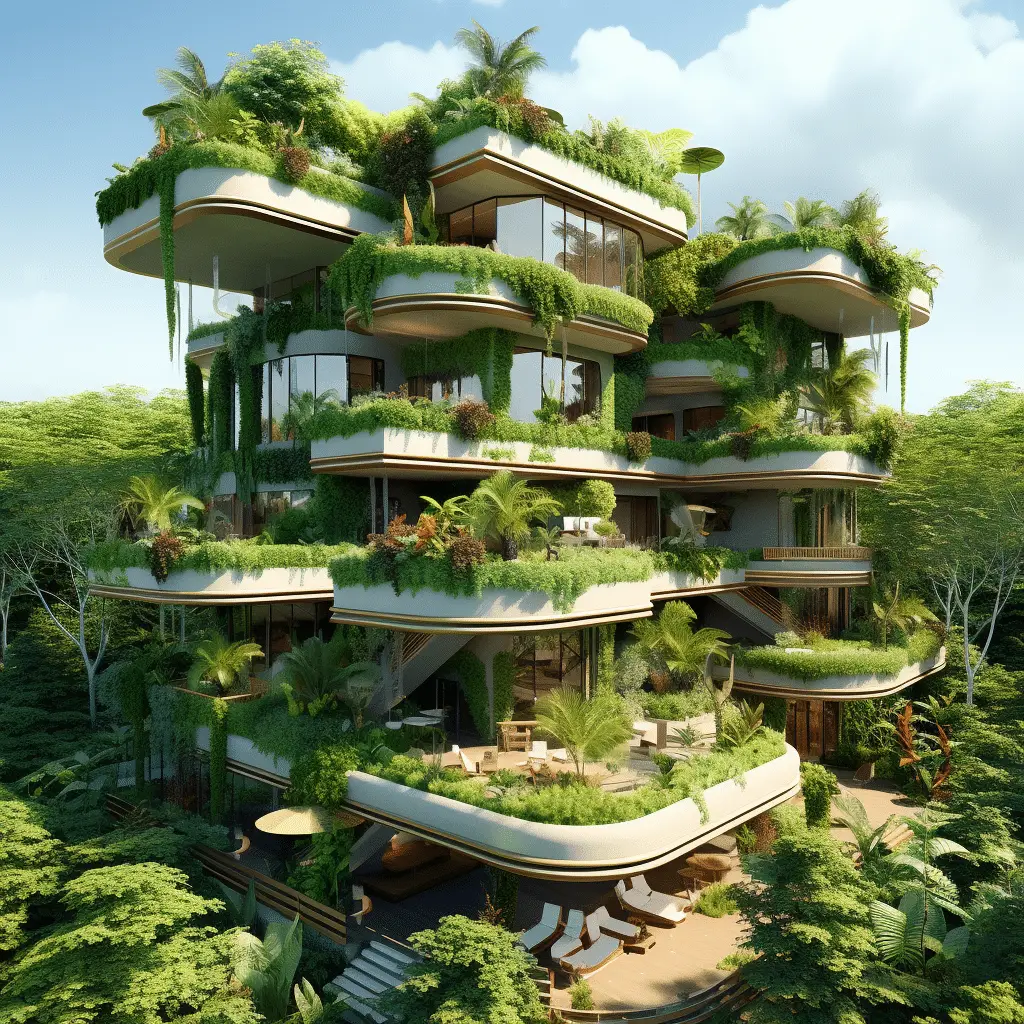
Optimizing operational and maintenance practices is crucial for sustainable building design, as it ensures long-term energy efficiency, cost savings, and effective waste management. By implementing sustainable practices throughout the lifespan of a building, owners can minimize environmental impact and create a more sustainable future.
One key aspect of optimizing operational practices is the regular monitoring and maintenance of building systems. This includes HVAC systems, lighting, and water management systems. By conducting routine inspections and making necessary repairs or upgrades, building owners can ensure that these systems operate at peak performance, reducing energy waste and lowering operational costs.
Effective waste management is another critical component of sustainable building design. This involves implementing recycling programs, composting, and utilizing sustainable materials that can be easily reused or recycled. By reducing waste sent to landfills and promoting responsible disposal practices, building owners can minimize their carbon footprint and contribute to a circular economy.
Additionally, incorporating smart technologies and automation systems can enhance energy efficiency and improve occupant comfort. By utilizing sensors, building management systems can optimize lighting and temperature settings based on occupancy levels, reducing energy consumption without sacrificing comfort. These innovative technologies not only reduce operational costs but also enhance the overall performance and sustainability of the building.
| Benefits of Optimizing Operational and Maintenance Practices: |
|---|
| Increased energy efficiency |
| Cost savings through reduced energy consumption |
| Improved waste management and reduced landfill waste |
| Enhanced occupant comfort and productivity |
In conclusion, optimizing operational and maintenance practices is essential for sustainable building design. By prioritizing energy efficiency, waste management, and smart technologies, building owners can create environmentally responsible structures that not only contribute to a greener future but also offer long-term cost savings and improved occupant well-being.
Conclusion
In conclusion, sustainable building design helps develop eco-friendly buildings that reduce environmental impact, save money, and improve occupant health. Sustainable design is the first step toward a greener future.
Sustainable building design must include site potential, energy use, water conservation, and indoor environmental quality. Architecture, construction, planning, interior design, and landscaping may create energy-efficient, resource-conscious, and ecologically friendly structures.
Passive and active sustainable design are fundamental to sustainable building design. Passive design uses sunshine, wind, and plants to reduce energy usage, while active design uses technology and renewable energy systems. Sustainable materials like renewable and recycled materials make the construction more eco-friendly.
Sustainable buildings reduce waste and energy use by streamlining operations and maintenance. Implement energy management, effective insulation, smart lighting, and water-saving technologies. Result: reduced environmental impact and significant economic savings for building owners and tenants.
Sustainable building design takes into account the environment, occupant health, and economic benefits over time. Sustainable design may make buildings energy-efficient, environmentally friendly, and contribute to a greener world.
FAQ
Q: What is sustainable building design?
A: Sustainable building design involves incorporating sustainable architecture, construction, planning, interior design, and landscaping techniques to minimize negative impacts on the environment.
Q: Why is sustainable building design important?
A: Sustainable building design is important because it reduces environmental impact, offers cost-saving benefits, and improves the health and well-being of occupants.
Q: What are some strategies for sustainable building design?
A: Strategies for sustainable building design include passive and active sustainable design, the use of renewable energy systems, and the implementation of sustainable materials.
Q: How can site potential be optimized in sustainable building design?
A: Site potential can be optimized in sustainable building design through factors such as site selection, orientation, and landscaping techniques that minimize environmental impact.
Q: How can energy use be optimized in sustainable building design?
A: Energy use can be optimized in sustainable building design through techniques such as efficient insulation, smart lighting systems, and energy management strategies that reduce overall energy consumption.
Q: How can water be protected and conserved in sustainable building design?
A: Water can be protected and conserved in sustainable building design through the use of water-efficient systems, rainwater harvesting, and other techniques that minimize water waste.
Q: How can indoor environmental quality be enhanced in sustainable building design?
A: Indoor environmental quality can be enhanced in sustainable building design through natural lighting, ventilation systems, and the use of non-toxic materials to create healthy and comfortable indoor spaces.
Q: How can operational and maintenance practices be optimized in sustainable building design?
A: Operational and maintenance practices can be optimized in sustainable building design through strategies and best practices that reduce energy consumption and minimize waste throughout the building’s lifespan.



